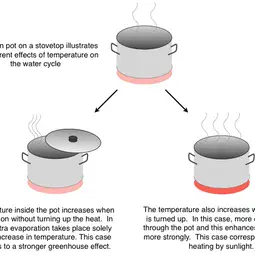Geoengineering approaches to reduce climate change unlikely to succeed
Reducing the amount of sunlight reaching the planet’s surface by geoengineering may not undo climate change after all. Two German researchers used a simple energy balance analysis to explain how the Earth’s water cycle responds differently to heating by sunlight than it does to warming due to a stronger atmospheric greenhouse effect. Further, they show that this difference implies that reflecting sunlight to reduce temperatures may have unwanted effects on the Earth’s rainfall patterns. The results are now published in Earth System Dynamics, an open access journal of the European Geosciences Union (EGU).
Global warming alters the Earth’s water cycle since more water evaporates to the air as temperatures increase. Increased evaporation can dry out some regions while, at the same time, result in more rain falling in other areas due to the excess moisture in the atmosphere. The more water evaporates per degree of warming, the stronger the influence of increasing temperature on the water cycle. But the new study shows the water cycle does not react the same way to different types of warming.
Axel Kleidon and Maik Renner of the Max Planck Institute for Biogeochemistry in Jena, Germany, used a simple energy balance model to determine how sensitive the water cycle is to an increase in surface temperature due to a stronger greenhouse effect and to an increase in solar radiation. They predicted the response of the water cycle for the two cases and found that, in the former, evaporation increases by 2% per degree of warming while in the latter this number reaches 3%. This prediction confirmed results of much more complex climate models.
“These different responses to surface heating are easy to explain,” says Kleidon, who uses a pot on the kitchen stove as an analogy. “The temperature in the pot is increased by putting on a lid or by turning up the heat – but these two cases differ by how much energy flows through the pot,” he says. A stronger greenhouse effect puts a thicker ‘lid’ over the Earth’s surface but, if there is no additional sunlight (if we don’t turn up the heat on the stove), extra evaporation takes place solely due to the increase in temperature. Turning up the heat by increasing solar radiation, on the other hand, enhances the energy flow through the Earth’s surface because of the need to balance the greater energy input with stronger cooling fluxes from the surface. As a result, there is more evaporation and a stronger effect on the water cycle.
In the new Earth System Dynamics study the authors also show how these findings can have profound consequences for geoengineering. Many geoengineering approaches aim to reduce global warming by reducing the amount of sunlight reaching the Earth’s surface (or, in the pot analogy, reduce the heat from the stove). But when Kleidon and Renner applied their results to such a geoengineering scenario, they found out that simultaneous changes in the water cycle and the atmosphere cannot be compensated for at the same time. Therefore, reflecting sunlight by geoengineering is unlikely to restore the planet’s original climate.
“It’s like putting a lid on the pot and turning down the heat at the same time,” explains Kleidon. “While in the kitchen you can reduce your energy bill by doing so, in the Earth system this slows down the water cycle with wide-ranging potential consequences,” he says.
Kleidon and Renner’s insight comes from looking at the processes that heat and cool the Earth’s surface and how they change when the surface warms. Evaporation from the surface plays a key role, but the researchers also took into account how the evaporated water is transported into the atmosphere. They combined simple energy balance considerations with a physical assumption for the way water vapour is transported, and separated the contributions of surface heating from solar radiation and from increased greenhouse gases in the atmosphere to obtain the two sensitivities. One of the referees for the paper commented: “it is a stunning result that such a simple analysis yields the same results as the climate models.”
###
Please mention the name of the publication (Earth System Dynamics) if reporting on this story and, if reporting online, include a link to the paper (http://www.earth-syst-dynam.net/4/455/2013/esd-4-455-2013.html) or to the journal website (http://www.earth-system-dynamics.net).
More information
This release is based on materials provided by the Max Planck Institute for Biogeochemistry.
This research is presented in the paper ‘A simple explanation for the sensitivity of the hydrologic cycle to surface temperature and solar radiation and its implications for global climate change’ published in the EGU open access journal Earth System Dynamics on 05 December 2013.
Full citation: Kleidon, A. and Renner, M.: A simple explanation for the sensitivity of the hydrologic cycle to surface temperature and solar radiation and its implications for global climate change, Earth Syst. Dynam., 4, 455-465, doi:10.5194/esd-4-455-2013, 2013.
The team is composed of Axel Kleidon and Maik Renner from the Max Planck Institute for Biogeochemistry (Jena, Germany).
The European Geosciences Union (www.egu.eu) is Europe’s premier geosciences union, dedicated to the pursuit of excellence in the Earth, planetary, and space sciences for the benefit of humanity, worldwide. It is a non-profit interdisciplinary learned association of scientists founded in 2002. The EGU has a current portfolio of 15 diverse scientific journals, which use an innovative open access format, and organises a number of topical meetings, and education and outreach activities. Its annual General Assembly is the largest and most prominent European geosciences event, attracting over 11,000 scientists from all over the world. The meeting’s sessions cover a wide range of topics, including volcanology, planetary exploration, the Earth’s internal structure and atmosphere, climate, energy, and resources. The 2014 EGU General Assembly is taking place is Vienna, Austria from 27 April to 2 May 2014. For information regarding the press centre at the meeting and media registration, please check http://media.egu.eu closer to the time of the conference.
If you wish to receive our press releases via email, please use the Press Release Subscription Form at http://www.egu.eu/news/subscribe/. Subscribed journalists and other members of the media receive EGU press releases under embargo (if applicable) 24 hours in advance of public dissemination.
Contact
Axel Kleidon
Max Planck Institute for Biogeochemistry
Jena, Germany
Tel.: +49-3641-576217
Email akleidon@bgc-jena.mpg.de
Bárbara Ferreira
EGU Media and Communications Manager
Munich, Germany
Phone +49-89-2180-6703
Email media@egu.eu
Links
- Scientific paper
- Journal – Earth System Dynamics
- Read this press release in simplified language, aimed at 7–13 year olds, on our Planet Press site



